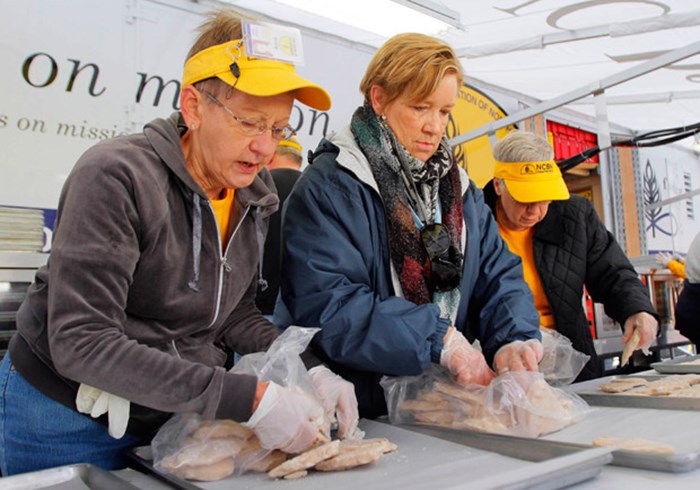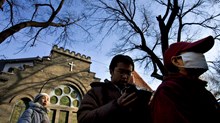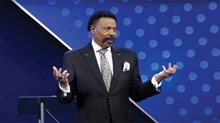
When Hurricane Sandy churned up devastation in the Northeast last week, fresh Southern Baptist church plants—part of a new urban emphasis the Convention rolled out this summer—mobilized to help.
"I keep thinking, 'What if we weren't here?'" said Sterling Edwards, who planted a Southern Baptist church in Long Island six years ago, and a second about eight months ago. "What if we weren't mobilized and not able to reach out? Because we're seeing impact."
Edwards has opened up both his churches for disaster relief, offering showers, food storage, and a place to sleep for a team of about 50 disaster relief workers.
"One of the major obstacles for church planters [in New York] is that we live in a community with no perceivable, tangible need," he said. "So when a storm like Sandy comes along, it reveals the vulnerability of our community and in that sense, there is opportunity for us to be able to truly minister to people."
While the material need isn't always there, the spiritual need on Long Island is great, he said.
Indeed, the northeast is now the most un-churched part of the country, according to a 2008 American Religious Identification Survey. About 22 percent of adults in the northeast self-identified their religion as "none" in 2008, up from 8 percent in 1990.
"In Mississippi, there are about 65 people per square mile, and one evangelical church for every 750 people," said Aaron Coe, vice president for mobilization at the SBC's North American Mission Board (NAMB). "In New Jersey, there are 1,100 people per square mile, and one church for every 7,500 people."
That need hasn't gone unnoticed by the SBC's North American Mission Board, which introduced a new initiative this summer to put 15,000 new churches in 30 American and Canadian cities in the next 10 years.
The goal of the Send North America plan is significant but not out of reach for the denomination, which plants about 1,000 new churches a year, said Coe.
"If we were to plant 1,500 churches a year, it would be the first time we planted churches at the same rate the population is growing," he said.
It would also help to stave off the death rate—about 880 SBC churches die annually, according to former NAMB Vice President Larry Wynn.
NAMB will be spending more than 50 percent of its budget on church planters—and it's changing its church planting funding strategy to become more realistic, Coe said.
"The bottom line is we've moved away from a one-size-fits-all approach to funding," he said. That $24,000 a year stipend doesn't stretch very far in cities like New York or Boston.
"In the past, the way we paid them, they couldn't afford to live on what they were doing," said Coe, who worked as church planter in New York City for 9 years. "We've moved to a model that basically looks at a church planter's strategy for that city and then determines, based on that strategy, how we want to fund it. Sometimes that's full-time funding, and sometimes he'll be bi-vocational."
Funding isn't the only thing that's changed, Coe said. Policies have, too.
"At the bedrock of the Send North America strategy is the idea that churches plant churches," he said. "Denominations and mission boards come alongside of existing churches and help them reproduce themselves."
That emphasis provides an immediate support network, he said. No longer are church planters tossed into a city to make it on their own, he said. Instead, existing churches will provide support for their own planter, and whenever possible, planters will work in teams, he said.
The SBC has already seen some growth in the Northeast, where planters started 118 churches in the past five years, NAMB Church Planting Director Steve Nerger said.
"Of the group, we only lost four of them," he said. "It's tremendous."
Some of the church plants are using the Great Commission Baptist name, an option narrowly passed by the SBC this summer, according to Mike Ebert, NAMB's vice president of communications.
"It is a help in regions outside the South," he said. "We haven't picked up on a big trend with our planters using it yet, but we have heard of some."
But some planters aren't finding any advantage from the name change.
"It almost never comes up," Edwards said. "It has no bearing on our day to day. Honestly and truly, the average person would just know that we're not Catholic. We let people know when they come to a new members' class or something like; we're not ashamed to be Southern Baptists at all, but that's Southern Baptist having those discussions. Our community is not having those discussions."
John Ridenour, who pastors a planting church in Massachusetts, agreed.
"Hardly anybody in our church knows [which denomination] you are," he said. "The older folks do. We still have founding members in our church so they do. But it's a cultural shift. In 1960 people were loyal to their lodge, their job, their church. That's not true at all anymore."
But the new support from NAMB will help growth exponentially, Nergersaid. Planting missionaries will be assigned to Connecticut, Maine, Rhode Island, South New Jersey, and Vermont—the first full-time missionaries to be fully funded by NAMB in those states.
"Before we had three full-time church planting people for New England," he said. "Now we'll have about 10. It's a huge difference."
Several church planters, like Edwards, were already in place when Hurricane Sandy hit.
And while Edwards and his team is helping Sandy victims with no strings attached, they're also sharing the gospel, and new families showed up at both churches for services Sunday, he said.
It's encouraging for Edwards, who wants to start two more churches in the Long Island area by 2014.
"For us to have a facility on the ground is an incredible provision," he said."It's giving us a very unique seat to be able to share the love of Christ for our community."

Support Our Work
Subscribe to CT for less than $4.25/month


















